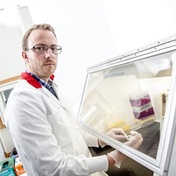A team of scientists in the United States has shown in experiments how to construct complex, spherical objects with tiny strings of DNA that assemble by themselves.
DNA nanotechnology uses the building blocks of living organisms not as a repository for biological data, but as a structural material instead.
These molecular-scale biomaterials hold tremendous promise in fields ranging from robotics to electronics to computation, scientists say.
One of the ultimate goals is the self-assembling biochips for nano-computers, according to New York University chemist Nadrian Seeman, a leading expert on DNA-based technology.
Whether synthetic or natural, DNA strands often display properties that cannot be duplicated in conventional organic or inorganic chemistry.
Such biomaterials have the added advantage of being a renewable resource and, by definition, biodegradable.
Basic building blocks of all life
The DNA double helix structure consists of two intertwined spirals of sugar and phosphate molecules linked by pairs of nucleotides, the basic building blocks of all life.
In nature, the double helix is about two nanometres wide, and varies in length depending on the organism whose genetic codes it contains. In humans, the DNA ladder consists of some three billion "rungs," or base pairs, that would stretch out nearly a meter (yard) in length if unfolded.
Some two-dimensional DNA nanostructures have already been made by coaxing DNA molecules to interact and lock together in such a way as to produce a desired pattern.
But larger and three-dimensional forms have been harder to make using existing methods because of the need to manipulate hundreds of unique DNA strands.
A team of researchers led by Chengde Mao of Perdue University in Illinois overcame this problem by programming the DNA to first fold into a basic, "pre-fab" structural unit shaped like a three-pointed star.
This made it easier for these uniform units to coalesce into five- or 12-sided geometric forms, or even "buckyballs", molecules with 32 sides composed of 20 hexagons and 12 pentagons.
"We expect that our assembly strategy can be adapted to allow the fabrication of a range of relatively complex three-dimensional structures," the researchers concluded. – (Sapa
Read more:
DNA decoding made easy
DNA computer to fight cancer
March 2008




 Publications
Publications
 Partners
Partners














